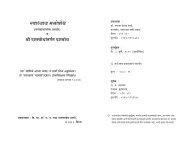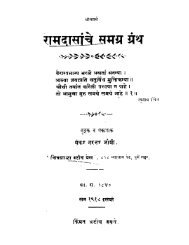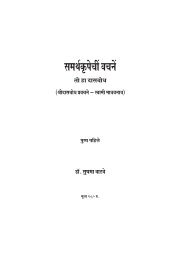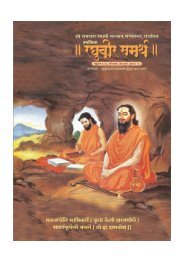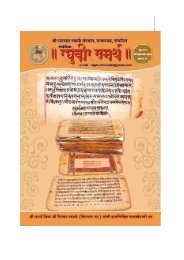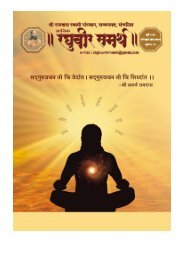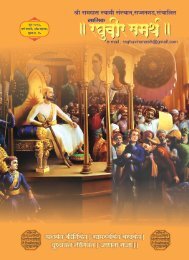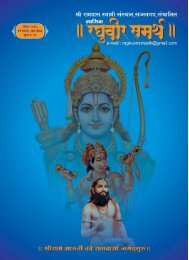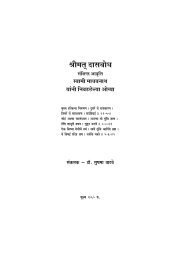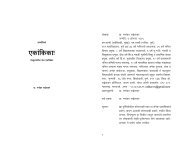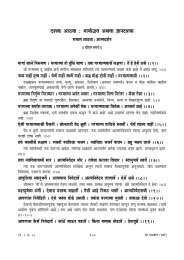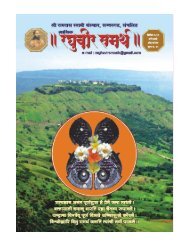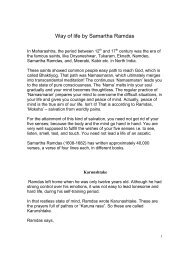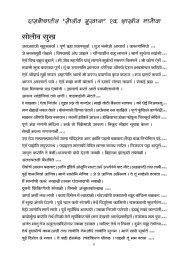THE DASBODHA BY: SADGURU SHREE SAMARTH RAMDAS ...
THE DASBODHA BY: SADGURU SHREE SAMARTH RAMDAS ...
THE DASBODHA BY: SADGURU SHREE SAMARTH RAMDAS ...
You also want an ePaper? Increase the reach of your titles
YUMPU automatically turns print PDFs into web optimized ePapers that Google loves.
many a times in the Dasbodha tells that the only solution to this problem is following the path of<br />
spiritualism. Spiritualism is nothing but living life for the God while constantly remembering him.<br />
The God is the timeless flame of knowledge which resides everywhere in the universe, which is<br />
unbreakable, complete in every imaginable sense, is the source of light making the luminescent<br />
glow and hence is the cause of all the visible and the invisible. He resides in our heart, is our<br />
Atman, and is everything for us. The Atman is with us right from the time of our birth till death, in<br />
each action or inaction. Therefore it is possible to leave anything and everything in our life but it is<br />
well nigh impossible to leave our Atman. All our problems have emanated from the fact that we<br />
have forgotten our Atman and have paid all the attention to the body. If we succeed in remembering<br />
the Atman all the time we will also come to know the continuous flow of life. Shree Samarth says<br />
that leading a family life and leading a spiritual life are not different forms of leading a life. They<br />
are merely two different views of looking at the free flowing life. According to him it is foolish to<br />
separate family life and spiritualism. Both of them can and should go hand in hand. He even says<br />
that a Sanyasi who is disillusioned with the family life has the right given by the religion to advise<br />
those leading family life on matters where they seek it. Hence leading a family life and becoming a<br />
Sanyasi are the two sides of the same coin. To gain a proper perspective of both one needs to<br />
metamorphose one’s own mind to completely change one’s view of life wherein he sees both sides<br />
of the coin simultaneously and what is more important, understands the interrelationship between<br />
them. Our life itself is a continuous Sadhana. The life as already said is free flowing but is<br />
obstructed by our pride, the feeling of me and also the feeling that it is me who is doing all these<br />
things, which in turn divides this flow leading to duality. This finally leads to waves of disturbances<br />
in the free flowing life. The vice of pride is bemusing. It has an end so has the mind but the<br />
combination of both try to capture the God which obviously is impossible. It can be understandable<br />
if one tries to get something by himself which he doesn’t possess but not putting his heart out for<br />
getting something which is well within himself is a sign of foolishness.<br />
The pride goes on vanishing by the continuous remembrance of the<br />
God, the life becomes free flowing, you do your job but without ascribing it or crediting it to me,<br />
this is sort of golden Sadhana. Shree Samarth calls this as the self realization, the consequence of<br />
which is effortless Samadhi and all of it culminates into appearance of the Parbrahma for you to<br />
experience. It is the gift of the God and the Guru. In the effortless Samadhi you are not there in the<br />
body which is occupied finally by the Parbrahma. Whatever the outside world perceives as being<br />
done by you is in fact done by the Parbrahma.<br />
One who by effort kills the feeling of me experiences a peculiar<br />
contradiction. In the earlier phases of Sadhana one is very enthusiastic about doing it but it is his<br />
me who has to do it. After a point of time when he does the Sadhana correctly as told by his Guru<br />
he realizes the abstract principle that unless he sheds off this me he would never get to the God. He<br />
is again confronted with an insurmountable difficulty, for the solution of which he approaches his<br />
Guru. His total surrender to the God and the Guru leads to their blessings leading to the effortless<br />
Sadhana the fruit of which is Parbrahma. Shree Samarth firmly believes that once the me in you<br />
goes away from your mind the God enters there and you then become the temple of the God<br />
yourself. At this stage your life becomes utmost pious, utterly unselfish and totally meant for<br />
others. Your life becomes seamlessly happy from within and without and the reflections of that are<br />
seen in the lives of others who are in your company. Shree Samarth advises that such people should<br />
actively organize the society and cajole them to adopt the correct path in their lives so that<br />
everybody gets the same outcome as the fruit of their efforts. He also says that a family man who<br />
after great efforts attains a stage wherein he can have self realization and can go in to the state of



